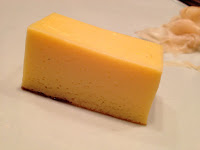So as every great food trip deserves a sort of exclamation point at the end, we had ours in the form of a lunch at Sushi Kanesaka (鮨かねさか). Everybody who goes to Japan knows the following: everything you get just by walking into a joint off the street is pretty good, kaiten-zushi (回転寿司) is something you should do at least once, and the really good sushi places that get accolades like Michelin Stars are so good that you should damn well feel unworthy. Well, maybe that's a little harsh. For the prices that the really good restaurants charge, you are getting what you deserve. But for sushi connoisseurs for which the local sushi take out joint is so bad that it disappoints you even when at your most desperate hour, there is always a feeling when going to a great sushi restaurant that you want to just soak it all in, making sure to preserve those delicious memories of rice, seafood, and other delicacies so that when you are at another grim hour, you can at least remember why it's worth the wait to next time. Aha moments, closed eyes, squeals of glee, and proclamations that there is a God. That's good sushi.
If you are at this point in your life where you want the best sushi, but do have financial limitations, I feel for you. There are some work arounds we've found. One is to buy a Michelin Guide, and look for the sushi restaurants with stars that have a more affordable lunch option. You may have to book well in advance, but it's always worth planning, and if you're staying at a good hotel, you can ask them to make the reservation for you. We had great luck when asking our hotel to book a lunch reservation at Sushi Kanesaka.
 |
| View from across the street when standing in front of the restaurant |
 |
| Sushi Kanesaka's red noren curtain |
 |
| The sushi bar |
 |
| Chef Sanpei |
And so the meal started. Brace yourself. It was outstanding.
 |
| Wakame and myoga salad |
 |
| Hirame |
 |
| Shimaji |
 |
| Maguro |
 |
| Toro |
 |
| Slicing the ika |
 |
| Ika nigiri |
 |
| Prawn with tiny baby shrimp paste on the inside |
 |
| Kisu |
 |
| Tai |
 |
| Aji |
 |
| Katsuo |
 |
| Clam miso soup |
 |
| Surf clam |
 |
| Hotategai (baby scallops) |
 |
| Uni |
 |
| Anago |
 |
| Sweet egg omelet |
 |
| Maguro maki |
ごちそうさまでした! An amazing meal. A feast if ever there was one, and clearly the best sushi experience of my life. From the revelation of sweet tai to the lean maguro to the live surf clam to the sweet egg omelet and back again. I think that this sushi lunch at Sushi Kanesaka, at the hand of the skilled Chef Sanpei, and the gracious service of the other chefs contributing to the meal, was one of the finest meals I've ever eaten. I believe that it was worth every penny, and covered a diverse set of the freshest, expertly prepared fish available in Japan. I thank everyone for the meal, and highly recommend that if you are looking for one place to go to make the commitment and get a reservation at Sushi Kanesaka.
DETAIL RUNDOWN:
鮨かねさか
Japan, Tokyo, Chuo, Ginza, 8−10−3 銀座三鈴ビル B1F



































